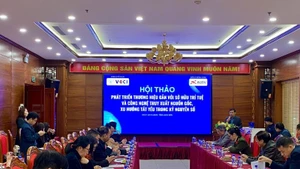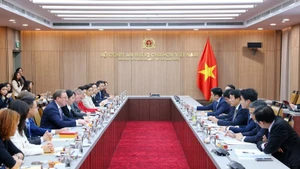In the digital age, the application of technology to preserve and digitise these languages has become not only necessary but urgent. Yet, this endeavour faces significant challenges that demand thoughtful and effective solutions.
Minority languages face the threat of extinction
Dr Phan Luong Hung of the Institute of Linguistics notes that approximately 33 to 34 ethnic groups in Viet Nam possess their own writing systems. Alarmingly, languages belonging to groups with populations under 1,000—such as the Brau, Si La, Ro Mam, Pu Peo, and O Du—are at risk of being forgotten.
In many ethnic minority communities, the number of native speakers is dwindling. A 2019 socio-economic survey by the National Statistics Office revealed that only 58% of ethnic minority individuals under 18 could speak their native language, and just 16% of those aged 15 and above could read and write it.
A 2019 socio-economic survey by the National Statistics Office revealed that only 58% of ethnic minority individuals under 18 could speak their native language, and just 16% of those aged 15 and above could read and write it.
Linguistics experts warn that literacy rates among young ethnic populations may continue to decline due to cultural assimilation and the absence of robust, long-term strategies for language preservation. For smaller ethnic groups, limited usage and geographic isolation—often in mountainous regions—further hinder the transmission and visibility of their languages.
This lack of reach poses a major obstacle to research and conservation efforts. Without comprehensive policies from state authorities, the extinction of some minority writing systems appears inevitable.
UNESCO has reported that half of the world's languages are at risk of disappearing due to objective and subjective factors. Objective factors include the small number of speakers and environmental disasters, while subjective factors include political and economic pressures like globalisation and urbanisation.
These warnings are highly relevant to Viet Nam, where digitisation must complement educational initiatives to protect linguistic heritage.
Digitalisation as a key factor in language preservation

In today’s digital landscape, data preservation is synonymous with cultural survival. This is especially true for the writing systems of ethnic minorities, which require urgent attention.
The Vietnamese government has introduced various policies to promote ethnic minority cultures, including language preservation as a means of fostering national unity.
In line with this, the Institute of Linguistics launched a project to digitise minority languages. However, the initiative has encountered numerous technical and logistical hurdles.
Ethnic minority scripts vary widely: some derive from Sanskrit, others use Latin characters, while a few employ pictographs or Khmer-like scripts. This diversity complicates font standardisation and character encoding. Some fonts fail to meet Unicode standards, resulting in incorrect online display and loss of linguistic nuance.
Technology expert Dr Dang Minh Tuan advocates for a comprehensive character allocation plan to facilitate consistent and scalable digitisation. While technology is essential, human expertise remains central. The pool of individuals fluent in minority languages—and skilled in digital tools—is extremely limited.
Successful digitisation depends on collaboration between linguists and technologists. Linguists must refine each script, enabling developers to encode characters accurately. Dr Hung highlights that recent improvements in language education have generated valuable data for digitisation efforts.
Preserving and promoting minority writing systems affirms the equality of all ethnic groups and strengthens cultural identity. Digitisation is not only a technical task, it is a communal mission.
Resolution 57 from the Party Central Committee, which promotes innovation and digital transformation, has positively influenced cultural preservation.
Dr Hung believes that with sufficient funding and prioritisation of human resources, the digitisation project can be completed.
Debates continue around font standardisation. Some propose a unified script for all minority languages, others favour region-specific systems, and some insist on strict adherence to Unicode. Dr Hung maintains that any approach is viable, provided there is institutional commitment and resource allocation.
He emphasises that current funding for cultural preservation is fragmented and unfocused. Strategic prioritisation is essential to ensure meaningful progress.
Preserving and promoting minority writing systems affirms the equality of all ethnic groups and strengthens cultural identity. Digitisation is not only a technical task, it is a communal mission.
Public awareness and engagement must grow so that every individual becomes a cultural ambassador, preserving and celebrating their heritage through language.
















